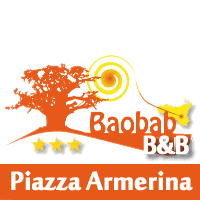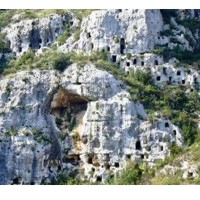Home - In and around
RESERVE OF PANTALICA IN NOTO SICILY
The Oriented Nature Reserve Pantalica, Valley Stream dell'Anapo and Cava Grande is a regional nature reserve in Sicily.
Territory
The reserve extends for most of the territories Ferla and Sortino where you'll find most of the catacombs. It is crossed by the river that flows through the canyon Anapo "V" characteristic of the area.
Flora
As a natural aspect, the reserve of Pantalica offers diverse ecological environments that allow the expression of a significant biodiversity. We have many different biotypes depending on the environment: an aquatic environment, a riparian (walls), one of the valley, the plains and caves. Along the river is an ever-growing vegetation in the eastern plane tree. On the rocks but there is the presence of oleander, perfectly suited to this climate. Among the trees dominate the willows, poplars black, ash, hornbeam and oak, while the undergrowth becomes intricate because of the brambles and plants such as clematis Lianos. Undergrowth of shrubs are also holly, hawthorn, and the mastic tree euphorbia bush. As flowers are cyclamen, daisies, field, flowers white wild garlic and yellow buttercups from the crown. Moving towards the walls of the valley there is the presence of the Mediterranean which consists of evergreen oaks, the oak, the mock privet and buckthorn.
Fauna
The torrential nature of the river environment provides the ideal un'habitat rare Sicilian trout (Salmo trutta macrostigma), present in very few other stations in Sicily, the brown trout (Salmo trutta fario) and tench (Tinca tinca). It is not uncommon to find even the eel (Anguilla anguilla) and the river crab (Potamon fluviatile).
Of the many birds of prey that once roamed this area survive only the peregrine falcon (Falco peregrinus) and a few rare examples of the Bonelli (Hieraaetus fasciatus), which feed on rabbits (Oryctolagus cuniculus) and partridges (Alectoris graeca) these species present among the low vegetation on the slopes. Among other bird species present deserves a nod the hoopoe (Upupa epops).
Other mammals are the fox (Vulpes vulpes), marten (Martes martes), weasels (Mustela nivalis) and porcupine (Hystrix cristata). In the bat cave and hospitality are also found in the cave many species of bats.
The varied and rich kingdom of amphibians, which are in the Reserve ideal living conditions, among them worth mentioning is the rare painting discoglosso (Discoglossus pictus).
Among the reptiles, we finally point out to the adder Riccioli (Coronella Gironde), a snake common in the countryside of the island, and some species of land tortoises (Emys orbicularis and Testudo hermanni).
Territory
The reserve extends for most of the territories Ferla and Sortino where you'll find most of the catacombs. It is crossed by the river that flows through the canyon Anapo "V" characteristic of the area.
Flora
As a natural aspect, the reserve of Pantalica offers diverse ecological environments that allow the expression of a significant biodiversity. We have many different biotypes depending on the environment: an aquatic environment, a riparian (walls), one of the valley, the plains and caves. Along the river is an ever-growing vegetation in the eastern plane tree. On the rocks but there is the presence of oleander, perfectly suited to this climate. Among the trees dominate the willows, poplars black, ash, hornbeam and oak, while the undergrowth becomes intricate because of the brambles and plants such as clematis Lianos. Undergrowth of shrubs are also holly, hawthorn, and the mastic tree euphorbia bush. As flowers are cyclamen, daisies, field, flowers white wild garlic and yellow buttercups from the crown. Moving towards the walls of the valley there is the presence of the Mediterranean which consists of evergreen oaks, the oak, the mock privet and buckthorn.
Fauna
The torrential nature of the river environment provides the ideal un'habitat rare Sicilian trout (Salmo trutta macrostigma), present in very few other stations in Sicily, the brown trout (Salmo trutta fario) and tench (Tinca tinca). It is not uncommon to find even the eel (Anguilla anguilla) and the river crab (Potamon fluviatile).
Of the many birds of prey that once roamed this area survive only the peregrine falcon (Falco peregrinus) and a few rare examples of the Bonelli (Hieraaetus fasciatus), which feed on rabbits (Oryctolagus cuniculus) and partridges (Alectoris graeca) these species present among the low vegetation on the slopes. Among other bird species present deserves a nod the hoopoe (Upupa epops).
Other mammals are the fox (Vulpes vulpes), marten (Martes martes), weasels (Mustela nivalis) and porcupine (Hystrix cristata). In the bat cave and hospitality are also found in the cave many species of bats.
The varied and rich kingdom of amphibians, which are in the Reserve ideal living conditions, among them worth mentioning is the rare painting discoglosso (Discoglossus pictus).
Among the reptiles, we finally point out to the adder Riccioli (Coronella Gironde), a snake common in the countryside of the island, and some species of land tortoises (Emys orbicularis and Testudo hermanni).



